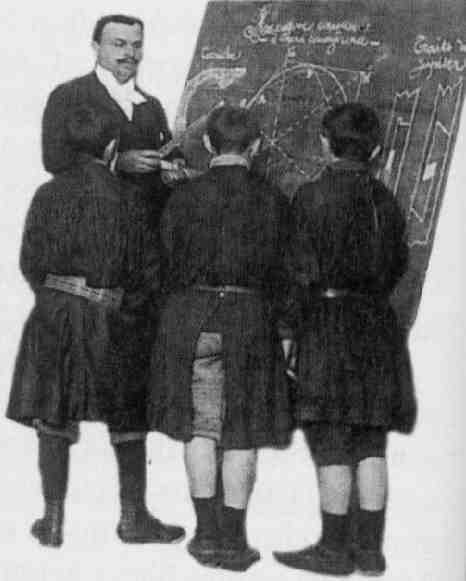
Figure 1.--This image shows a scene from a French lesson. The boys are all dark smocks. Two are clearly back buttoning, I'm not sure about the third. Each boy is wearing his belt outside his smock.


Figure 1.--This image shows a scene from a French lesson. The boys are all dark smocks. Two are clearly back buttoning, I'm not sure about the third. Each boy is wearing his belt outside his smock. |
HBC is just beginning to address the French custom of swearing belts over school smocks. Many modern smocks generally have a belt made in the same fabric as the smock itself. This was not the case in smocks made before World War I (1914-18). Only the boys wore belts over their smocks. Not all boys did this, but it was quite common. In many available images, however, quite a number of boys do. We have not noted the girls doing this. HBC is unsure about the oigins of this belt over style. Several explanations are possible or have been proposed by HBC readers. A French HBC contributor suggests that the belt-over style was adopted because of its military look. HBC does not have an adequate number of photographs from the early 20th century to reasonably assess the prevalence of wearing belts over smocks. We also do not know if there were regional or demographic differences involved.
Many modern smocks generally have a belt made in the same fabric as the smock itself. This was not the case in smocks made before World War I (1914-18). Self belted smocks appeared in the 1930s, but did not become the dominate style until the 1950s. One French HBC contributor reports, "It is true that, I would say before World War I, in France smocks were often worn in schools and colleges with a belt." This appears to have been quite common in available photographs. Only the boys wore belts over their smocks. Not all boys did this, but it was quite common. We have not noted the girls doing this.
HBC is unsure about the oigins of this belt over style. Several explanations are possible or have been proposed by HBC readers.
A French HBC contributor suggests that the belt-over style was adopted because of its military look. "In fact I would
rather say a military (or similar) belt (wide leather: in French "un ceinturon").
One must remember that France was severely defeated in 1870-71 by a German coalition,
two provinces (Alsace and Lorraine) were lost." The disaster of the Franco-Prussian War (1870-71) brought about the Second French Republic which as acdemocracizing reformmintroduced the smock to French schools. "L' esprit de revanche" (revenge
spirits) reigning everywhere in France and above all in the schools until 1914 when the Germand invaded Belgium and France initiating World War I. Pupils were paramilitary drilled and that spirits pervaded everywhere. Songs often had a martial air. That may explain this martial look given by the belt over the smock.
In a book Les disparus de Saint-Agil", one of the pupils, André Baume, 16 years
old, is depicted as wearing a rough black smock tightened in the waist par a military
belt ("ceinturon") with a brass buckle. The date is about June 1914.
This view is not shared by all our French HBC contributors. One French readers indicated in fact, I feel that the "military" interpretation on smock wearing is a bit far fetched."
Maybe it was not only the boys but also adults that had that fashion. Moving men (removal men) or workers having to lift heavy objects often wear such belts. Perhaps boys though this belt-over style looked more masuline. Notably the girls did not wear their smocks with belt over them. In fact, many girls wore their smocks without a waist gathering. The smock without a waist gathering in fact looks much more like a dress. Only boys wore their belts over their smocks. We have not noted the girls doing it.
A French contributor points out as late as 1900, France was still a very rural country, and the type of smocks shown on the photo looks very much like what the boys' fathers were
probably wearing all day long. HBC is unsure, however, if the smocks worn by French farmers and farm workers were worn with a belt over them.
HBC does not have an adequate number of photographs from the early 20th century to reasonably assess the prevalence of wearing belts over smocks. Not all boys wore their belts like this. In many available images, however, quite a number of boys do. We also do not know if there were regional or demographic differences involved.
